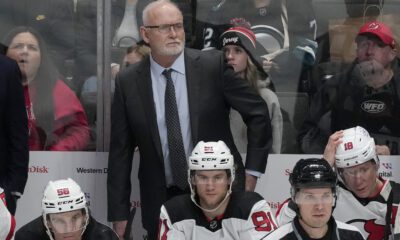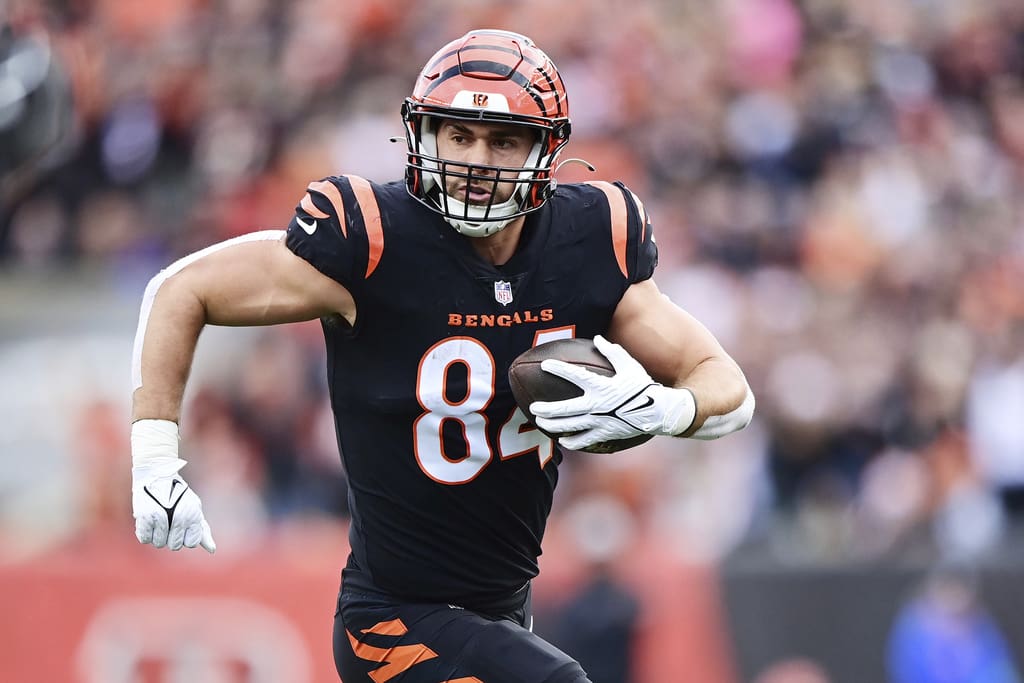Boston Bruins
Krejci Past, Present Quandary Key to Bruins Cup Dreams

When Brad Marchand set up David Pastrnak for the first goal of the Bruins’ trip-concluding, 4-2 loss at Colorado on Oct. 10, David Krejci could be seen crashing the net. The veteran center had just replaced Patrice Bergeron on a progressive line change and wound up looking all the part of what he had been for three glorious years that saw the Bruins reach two Stanley Cup finals.
It’s been easy to forget during the Czech center’s injury-plagued seasons in the middle part of the decade that he had led the NHL playoffs in scoring – twice – both in 2011 and 2013.
For three seasons, Krejci’s hockey sense and silky mitts made him the perfect orchestra conductor for the chaos created by linemates Nathan Horton and Milan Lucic.
Horton didn’t mow down defensemen like Lucic, but his swooping forecheck was equal parts Mark Messier and Glen Murray. At top speed, his arrivals were sudden and caused panic for puck fetchers. An elite prospect meandering into his prime years in Florida, Horton’s high skill level finally found its proper niche on Boston’s top line.
David Krejci, Then
The one season that Jarome Iginla patrolled Boston’s right wing (2013-14) gave the Krejci line a grind quality at the cost of Horton’s explosive stride. Iginla did score 30 goals, many filling the net in a late-season flurry like Christmas Eve stocking stuffers. Unfortunately for Iginla and the Bruins, their President’s Trophy campaign stood no realistic chance of playoff glory after the midseason loss of Dennis Seidenberg to ACL/MCL surgery left entry-level defensemen on all three pairings.
On the eve of the next season, Johnny Boychuk was traded for draft picks, and further decay among the returns from the Tyler Seguin trade set back the Bruins. Even more crippling was Krejci’s hip injury, limiting his 2014-15 season to 47 games. When he did play, he struggled to generate his customary speed carrying the puck through the middle of the rink.
Once a fixture on the top line, Lucic was a left winger on an island. He would find a temporary home on a makeshift trio with part-timer Ryan Spooner and rookie David Pastrnak, but he, too, would soon be out west after Don Sweeney replaced Peter Chiarelli as general manager and was charged with the dual task of replenishing the prospect pool and creating the salary-cap space needed to reload.
Many expected Sweeney to move Krejci and his $7.25 salary to achieve cap relief at a time when the latter’s health was questionable and his production slipping amidst a revolving door of linemates on what seemed like monthly auditions.
Krejci’s popularity sank with the team’s fortunes — the Bruins missed the playoffs on the final weekend of consecutive seasons — and he, goaltender Tuukka Rask and veteran forward Chris Kelly were roundly criticized for their contracts.
Amidst speculation that the Bruins might blow up their team, Bruins owner Jeremy Jacobs openly respected what then-Detroit GM Ken Holland had accomplished in maintaining his veteran core from 2002 and reloading for consecutive runs to the 2008 and ’09 Cup finals that yielded another championship.
For Boston, that would mean rebuilding around Bergeron, Chara, Krejci, Marchand and Rask.
It worked.
David Krejci Future, Linemates, Injuries
Now 33, Krejci had turned 29 less than a month before Sweeney took the reins and began reshaping the Bruins into the group we know today.
Prior to gaining a left winger in Jake DeBrusk, Krejci had a bounce-back season in 2016-17, finishing third in team scoring with 23-31-54 totals while playing in all 82 games for the first time in eight years. His playoff against Ottawa started with an upper-body injury that limited him to three games, the last being Game 5, where a knee-on-knee hit from Chris Wideman ended his playoffs.
When the 2017-18 season rolled around, Krejci was back and he got a new linemate in DeBrusk, who had spent the 2016-17 season developing in the AHL. DeBrusk would score in his NHL debut, earn himself a permanent roster spot and solve half the problem.
Coach Bruce Cassidy’s abiding decision to ride out the dominant trio of Bergeron, Marchand, and Pastrnak has left the question mark lingering on Krejci’s right wing.
Karson Kuhlman – picture a poor man’s right-shot version of Marchand, which means he’s a solid, 200-foot winger – has held the spot at times, but Kuhlman has missed time due to injury and Cassidy continued to experiment until Krejci also went out of the lineup.
The injury itself wasn’t a topic of major concern (Krejci was considered possible for Oct. 27 against the Rangers in New York), but in the penultimate year of his contract the Bruins must evaluate more earnestly how their team matches up without him.
David Krejci has this season and next remaining on his deal, at which time it is widely presumed the Bruins will have developed another NHL center to continue a succession plan that will allow his cap space to be used on younger players.
According to capfriendly.com, Krejc’s modified no-trade clause requires him to have submitted a 15-team list of acceptable destinations via trade.
The Charlie Coyle acquisition at the last trade deadline (for winger Ryan Donato) adds intrigue, as the Weymouth, Mass. native is coming into his prime years and is scheduled for free agency in 2020.
Coyle was a monster in Boston’s run to the 2019 Stanley Cup final that they lost in seven games to St. Louis, but his paltry 2019-20 regular-season numbers resemble last season’s quiet regular-season offense more than they do his epic playoff.
While that may render Coyle a non-answer as a potential Krejci replacement, his overall value to the Bruins is undeniable. In the worst of scoring slumps, Coyle is a power-skating bulldozer who gives the Bruins exactly what they need in a third-line linchpin. If they can lock him and his modest point total down at a reasonable price, his regular-season limitations will be considered more than acceptable.
And this brings us to the key question as the Bruins prepare to turn a significant page: What kind of Cup contender are they?
Heretofore, the Bruins have based their Cup-contention blueprint on a dominant middle. Krejci and Bergeron have played the part of Yzerman/Federov, Sakic/Forsberg, Modano/Niewendyk, Lecavalier/Richards and, in the salary-cap era, Staal/Brind’Amour, Crosby/Malkin, Kopitar/Carter and Backstrom/Kuznetsov.
It’s a luxury to wield a superstar winger as the Bruins now do with Marchand functioning for them much as Patrick Kane does for Chicago, Alex Ovechkin does Washington, Nikita Kucherov does for Tampa Bay and Vladimir Tarasenko does for St. Louis.
But an elite, playmaking winger does not a Cup contender make. Cam Neely, Rick Nash, Jarome Iginla and Artemi Panarin have all been bridesmaids but never the bride.
If a team isn’t two-deep elite down the middle, they must be built the Montreal way, or the New Jersey way, around a big-three on defense and the right goaltender.
The 1970s Canadiens did it around Ken Dryden with Larry Robinson, Serge Savard and Guy Lapointe; the Devils did it around Martin Brodeur with Scotts Niedermayer and Stevens and either Ken Daneyko (1995) or Brian Rafalski (2000, ’03); the 2007 Ducks did it with Niedermayer, Chris Pronger and Francois Beauchemin around J.S. Giguere; the Blackhawks with Duncan Keith, Niklas Hjalmarsson and Brent Seabrook around Antti Niemi (2010) and Corey Crawford (2013 and ’15); and finally the Blues with Alex Pietrangelo, Colton Parayko and Jay Bouwmeester around Jordan Binnington in 2019.
Did Ryan O’Reilly play great and deserve all the hardware? Absolutely. Was he year in and year out on anyone’s shortlist of elite centermen prior to that playoff performance?
Everyone’s got to contribute to win the Cup, but the Blues were built the Montreal/New Jersey/Chicago way, and now they’ve taken it a step further by acquiring Justin Faulk as a deputy Pietrangelo, fortifying the strength of their team by easing the transition game without sacrificing defense to do so.
Brilliant move.
But what about the Red Wings of Pavel Datsyuk, Henrik Zetterberg and Nicklas Lidstrom? Well, unlike the Yzerman/Federov era, Zetterberg wasn’t always at the center, and Lidstrom did have former lottery pick Brad Stuart, a veteran Rafalski and future franchise stalwart Niklas Kronwall around Chris Osgood in 2008 and ’09 (when they were within inches of forcing Game 7 into overtime).
The 2007-09 Red Wings were more built around defense than center, but in truth were a bit of the hybrid that the Bruins are fast becoming.
The next core of the Bruins will likely be based on the blue line with Charlie McAvoy and Brandon Carlo (and potentially an extension of Torey Krug), but so long as Bergeron patrols the middle and Marchand offers his elite performance on wing, a Krejci exit will not entirely alter what the Bruins have been in this era of Cup contention.
If David Krejci does leave the Bruins on terms other than his own, it’ll signify the end of an underrated tenure and a wonderful Boston sports career worthy of celebration at a later date.
Meantime, the Bruins are at an interesting crossroads because the David Krejci-quandary is about much more than an individual career, it’s about franchise direction, theory of hockey, what wins and what becomes of the Bruins without an elite talent in his spot.
— Mick Colageo has been covering the Bruins since 1991. Follow on Twitter @MickColageo.


















